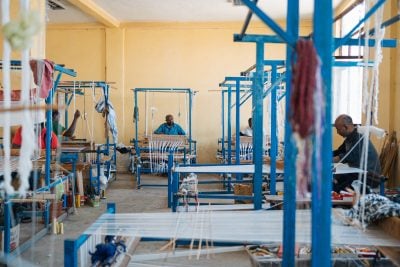The entry of FastJet, the African version of Europe’s EasyJet, into the East Africa aviation space is causing quite a stir. The new airline has promised fares that could be cheaper than those for buses on similar routes, let alone fares charged by other airlines. Expect a ding-dong battle for customers, writes our Kenya correspondent, Wanjohi Kabukuru.
We are not here for competition. We are here to offer a service that is very much needed in the continent,” Richard Bodin, FastJet Plc Chief Operating Officer says.
“It’s about democratising air travel, enabling huge numbers of middle-class African consumers to travel quickly, cheaply and safely.” Bodin was in Nairobi to set the tone for what is seen as a deliberate undertaking to write a new chapter of Africa’s aviation industry. It is not lost to aviation watchers why FastJet, billed as the continent’s ‘first pan-African low cost airline’ has chosen East Africa, and most specifically Nairobi to announce the launch of its operations in Africa.
Nairobi is East and Central Africa’s communications hub and home of one of the continent’s most successful airlines, Kenya Airways (KQ). However, while the announcement was made in Nairobi, FastJet’s first operational base is in Dar es Salaam, Tanzania, and Bodin explains why: “In Tanzania, the Fly540 brand will close down once we launch in a couple of weeks. In Nairobi, for some time, both brands will exist because there were some operational issues of flying an A319 in some destinations that Fly540 flies to. Both brands will operate alongside each other for some time.”
Events in the region’s aviation sector in the last year have shown a trend that has left many baffled. On the one side, the sector has been described as facing heady turbulent times. On the other, it has indicated a sense of buoyancy and bullish attitude to ward off the tough times. Indeed, for the last few weeks, reports on the region’s aviation industry have showcased a sector that was depressed and facing harsh economic times with little chance for profits in the near future.
In September, Virgin Atlantic announced that owing to low passenger numbers, increasing taxes and fuel costs, it was discontinuing its Nairobi – London flights. A month later in October, Bahrain’s Gulf Air became the second airline to stop flying to Nairobi. Add to these Kenya Airways’ retrenchment woes (See African Business, November 2012) and the scenario of a sector in crisis emerges. Interestingly, however, the main players are exhibiting a bold stance of optimism even in the face of shrinking profits.
Indeed, when Bodin announced that FastJet was going to be a point-to-point airline covering East African cities and towns for fares as low as $20, he seemed to be redefining the aviation industry in the continent and defying the current tide that calls for caution and guarded spending. “Our lowest fares stand at $20 and on average it will be $80,” Bodin explains. “We are not interested in a price war.”
He says the low-cost airline model uses lower fares to attract large numbers of additional passengers. The low fares target is to entice newer passengers who may have not flown before and instead spend long hours in bus travel to shift to the affordable airlines. “The global experience of launching a low-cost carrier is that it creates a completely new market rather than simply driving down prices in the existing market. We want to enable people to swap arduous bus journeys for convenient flights just as Brazil, Asia and Mexico have done.”
This strategy means that the airline will not only challenge other airlines but will carry the fight all the way down from the air to the land, aiming at inter-city and cross-border buses. The low fares that Bodin mentions are indeed lower than bus fares for Nairobi–Dar es Salaam/Nairobi–Kampala/Dar es Salaam–Kampala routes.
JamboJet throws down the gauntlet
FastJet’s story goes back to June this year when the UK-based investment firm, Rubicon, paid $86m to secure 49% of Lonrho’s aviation business Fly540. FastJet is the holding company of Fly540 and will use Fly540’s existing infrastructure, hubs and airline licences in Kenya, Tanzania, Angola and Ghana to operate. The new airline will deploy two Airbus A319s it has leased from Volito Aviation to begin its operations in Africa.
A year after its launch, FastJet expects to have 15 aircraft operating in the continent, five of which will be Airbus A319s. Another projection that FastJet is banking on is doubling Fly540’s current record of carrying 750,000 passengers in its first year of operations.
“Our intention is to generate a new market and not in any way to take the market share of the existing airlines,” Bodin says. FastJet also announced that it has contracted the exclusive services of Swissport International Ltd to provide ground handling and management service to FastJet across its operations and has also awarded a five-year contract to Sabena Technics for maintenance support of the airline’s fleet of Airbus A319s.
Incidentally, days before Bodin announced FastJet’s ambitious plans, Kenya Airways had already obtained a licence to launch its planned low-cost carrier (LCC) JamboJet. For KQ, the launch of JamboJet is expected to help shore up its fortunes not just in terms of profits but also in courting a favourable press after its retrenchment exercise, which affected some 578 employees, dented its reputation recently.
This is KQ’s second foray in the low-cost market. In 2004, KQ’s low-cost carrier Flamingo Airlines quit the low-cost business and was absorbed into the main group. It is will be different this time around, says KQ. “We have made a lot of progress with JamboJet and once we get the necessary approval, we should be ready to launch this financial year,” Titus Naikuni, the CEO of Kenya Airways, says.
According to Alex Mbugua, Kenya Airways’ finance director, JamboJet has hired staff for the launch: “The company will use the existing jets under a JamboJet logo and will also serve regional hubs such as Uganda, Rwanda, Burundi and South Sudan.” JamboJet will have its own branding, logo, colours and management team. JamboJet is expected to take over and complement KQ’s regional and domestic markets of Dar es Salaam, Hargeisa, Juba, Mwanza, Kisangani, Moroni, Mombasa, Malindi, Dzaoudzi, Pemba, Antananarivo, Bujumbura, Addis Ababa, Kilimanjaro and Entebbe.
Tougher competition ahead
The entry of low-cost carriers (LCCs) into the East African market has been in the works for some time now. Three years ago, talk of the launch of OneJetOne no-frills flight stirred the Kenyan aviation sector. Allegations of unfair advantage and political patronage surrounding the tendering process for OneJetOne’s operating licence resulted in the idea being shelved, even after it emerged that the airline had already secured $30m from Chinese investor. Nothing has been heard of it ever since.
FastJet’s daring entry through the acquisition of Fly540 and KQ’s recent raising of $170m through a public rights issue to finance its 10-year management and operations turnaround strategy are the third side of the coin that is the aviation story in East Africa. Indeed, while the sector has been sending mixed signals in the past, the last month has seen renewed vigour. Both airlines are squaring up for battle with fares being the new issue. It is clear this move will provide stiff competition and tougher times for other airlines such as RwandAir, Uganda Airlines, Precision Air (a subsidiary of KQ), Jetlink, AirKenya and ALS.
FastJet, however, downplays all mention of competition, only describing itself as offering a complementary service. “Customers will win as our fares will attract new passengers in the market. What we are doing is increasing the size of the market,” Bodin explains.
Want to continue reading? Subscribe today.
You've read all your free articles for this month! Subscribe now to enjoy full access to our content.
Digital Monthly
£8.00 / month
Receive full unlimited access to our articles, opinions, podcasts and more.
Digital Yearly
£70.00 / year
Our best value offer - save £26 and gain access to all of our digital content for an entire year!
 Sign in with Google
Sign in with Google 


